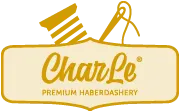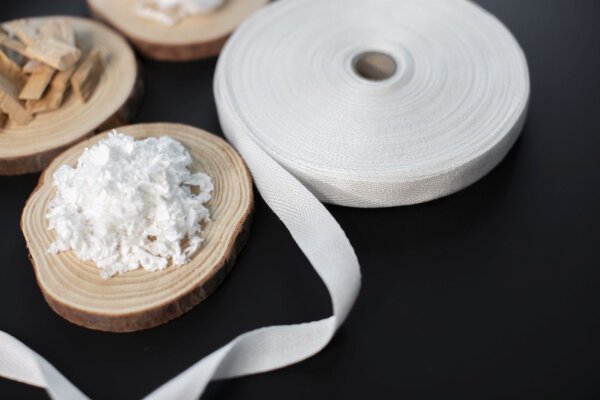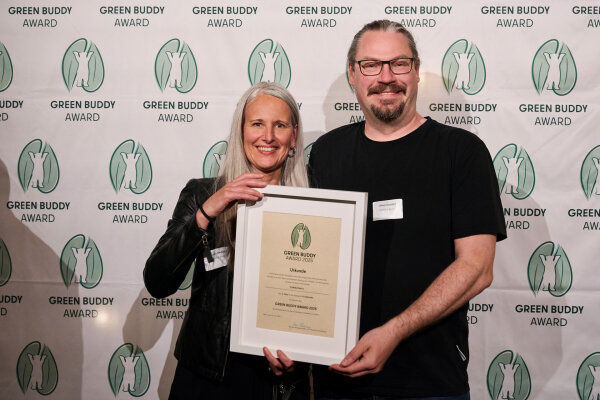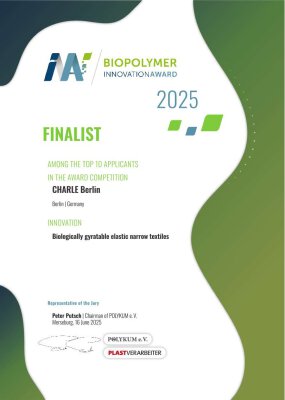
Blog
Sometimes change starts with something as small as an elastic bra strap. Together with Lenzing AG, we are introducing a new generation of plastic-free textile tapes: fully compostable, elastic tapes made from TENCEL™ Lyocell, TENCEL™ LUXE filament yarn and natural rubber. This collaboration takes us to the next level in achieving our goals: the development and production of fully renewable narrow fabrics. Foto: © TencelTM x CHARLE Berlin
We've done it again – we've won third place in the Green Buddy Awards in the retail category. The Green Buddy Award is a sustainability prize awarded by the Tempelhof-Schöneberg district office in Berlin, together with the economic development agency. It is aimed at companies, project groups, and private individuals who stand out for their particularly ecological ideas, innovative concepts, and sustainable commitment – either in the district itself or throughout Berlin. Photo: © Julia Merkel
We are delighted to announce that our elastic bands made from organic and bio-based materials have been named finalists for the Biopolymer Innovation Award. The jury recognized innovative product solutions in the field of sustainable polymers. In addition to our application, we submitted various versions of our plastic-free, elastic narrow textiles—developed for durable and recyclable applications in the textile industry.
Every piece of clothing has an end – but what happens after that? Most textiles end up as non-recyclable waste in incinerators or landfills. The reason: mixed materials, plastic, synthetic dyes. With CHARLE, I am pursuing a different path: 100% recyclable elastic bands , free of plastic, made from natural fibres. What we take from the earth should be able to return to it – without leaving any residue. Because recyclability is not a trend. It is the only future for a fashion industry that truly wants to be sustainable. In this article, I show why half-measures are not enough – and what we need to do differently if fashion is to become part of nature.
Sustainable fashion is on everyone's lips. Almost every label now has a green line, uses organic cotton or advertises with recycled materials. But what is really behind it? What good is the best cotton if plastic threads are invisibly woven into it? In this article, I explain why true sustainability doesn't start with fabrics – but with uncomfortable questions. I take you on my journey as a bridge builder in the fashion industry, as someone who never stops thinking ahead. Because real change doesn't come from trends – it comes from attitude.
As the founder of CHARLE, I didn't just design sustainable children's fashion – I also asked the seemingly simple question: ‘What's actually in elastic?’ The answer was shocking: plastic. But instead of giving up, I developed the world's first plastic-free elastic – and inspired an entire industry in the process.
We wanted to find out whether our elastic straps made from natural materials completely degrade in the soil within a year - a decisive criterion for compostability. To do this, we subjected one of our products to a comprehensive practical test. With the support of a worm farm in Austria, we were able to successfully carry out this test.
We have reason to celebrate – we have won two awards! Fairness First Award and Entrepreneur of the Future Award from the German Institute for Innovation for Sustainability and Digitalisation
Green Buddi Award - Logo --> GREEN BUDDY AWARD 2024 YEAH, we have won our first award. We won 3rd place in the "Retail" category for our commitment to sustainability, which we also
The cultivation of and the trade in natural rubber is not without its challenges of various kinds. The demand for the white gold is high, but the price is very low. So small, in fact, that the primary producers can barely make a living from it. We are lucky with our Malaysian supplier of natural rubber, as they already voluntarily take responsibility for their actions. Nevertheless, we go one step further and want to ensure that the farmers can make a good living from their work.










